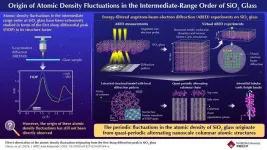(Press-News.org) Chocolate lovers may have been alarmed by a 2023 Consumer Reports finding that some dark chocolate brands could contain harmful levels of lead and cadmium.
However, a new study by Tulane University published in Food Research International has found that dark chocolate poses no adverse risk for adults and contains nutritionally beneficial levels of essential minerals.
The study sampled 155 dark and milk chocolates from various global brands sold in the United States and tested for the presence of 16 heavy metals ranging from the toxic (lead and cadmium) to the essential (copper, iron, zinc). The study then modeled the risk of eating one ounce of the chocolates per day which is equivalent to consuming more than two whole chocolate bars a week.
The research found that only one brand of dark chocolate exceeded the international limit for cadmium in bars containing more than 50% cacao (800 micrograms per kilogram) and only four dark chocolate bars had cadmium levels that could pose a risk to children weighing 33 pounds or less, the average weight of a 3-year-old in the U.S.
“For adults there is no adverse health risk from eating dark chocolate, and although there is a slight risk for children in four of the 155 chocolate bars sampled, it is not common to see a 3-year-old regularly consume more than two bars of chocolate per week,” said lead author Tewodros Godebo, assistant professor of environmental health sciences at Tulane University School of Public Health and Tropical Medicine. “What we’ve found is that it’s quite safe to consume dark chocolate and milk chocolates.”
When tested for lead, two chocolate bars contained levels above California’s interim standards for dark chocolates, but neither was determined to pose adverse risks to children or adults.
While two previous studies in the U.S. examined the presence of lead and cadmium in chocolate, this study employed the largest sample size, expanded the scope of testing to 16 metals, and included a risk assessment of toxic metals that accounted for the nutritional contribution of essential minerals.
The dark chocolates were found to contain high levels of nutrients such as copper, iron, manganese, magnesium and zinc, and several of the chocolates sampled provided more than 50% of the daily requirement for children and adults, Godebo said.
“Not only is it packed with these essential minerals, but they can potentially reduce the absorption of toxic metals in the intestine since these metals compete for the same site,” Godebo said.
The study found that much of the lead in chocolate comes from the post-harvest processing whereas cadmium comes from the soil and passes through the plant and into the cacao bean.
The researchers also sorted the chocolates geographically and found that dark chocolates from South America had higher levels of cadmium and lead than chocolates from Asia and West Africa, the latter of which is a primary source of dark chocolate for the United States.
“But even for chocolates from South America, we found there is no adverse risk in eating an ounce per day,” Godebo said.
END
A dark side to dark chocolate? New study finds very minimal risk for kids from metals in chocolates
2024-06-03
ELSE PRESS RELEASES FROM THIS DATE:
ECOG-ACRIN completes first trial of Black patients with early-stage breast cancer
2024-06-03
Black patients with early-stage breast cancer who were treated with docetaxel chemotherapy every 3 weeks had less drug-induced peripheral neuropathy and significantly fewer dose reductions compared to those who received weekly paclitaxel, according to a trial by the ECOG-ACRIN Cancer Research Group (ECOG-ACRIN). Study EAZ171 is the first National Cancer Institute (NCI)-sponsored trial to focus specifically on enrolling a minority or underserved population to assess drug-induced toxicity (rather than drug efficacy) ...
Understanding the atomic density fluctuations in silica glass
2024-06-03
In materials science, particularly in the study of glasses, the intermediate range order (IRO) is one of the most intriguing research areas owing to its significant influence over the physical properties of glasses. The IRO refers to the structural arrangement of atoms beyond the short-range order (atomic arrangement within a few atomic distances) but shorter than the long-range order (arrangement patterns over macroscopic distances). Notably, for covalent glasses, the IRO is marked by atomic density fluctuations.
Scattering experiments provide a distinct signature of ...
Crucial shift in River Nile’s evolution during ancient Egypt discovered
2024-06-03
Crucial shift in River Nile’s evolution during ancient Egypt discovered
Researchers have explored how the River Nile evolved over the past 11,500 years and how changes in its geography could have helped shape the fortunes of ancient Egyptian civilisation.
Research published in Nature Geoscience reveals a major shift in the Nile around four thousand years ago, after which the floodplain in the Nile Valley around Luxor greatly expanded.
The findings raise the possibility that this shift could have contributed to the success of the ancient Egyptian agricultural economy at points between the Old and New Kingdom periods. ...
Study shows college students have less empathy when they are less alert
2024-06-03
DARIEN, IL – A new study to be presented at the SLEEP 2024 annual meeting found robust evidence that implicates lower alertness, a key outcome of insufficient sleep, as a predictor of muted empathic responding, which suggests alertness may support both cognitive and affective empathy.
Results show that slower response times on objective alertness tests were significantly associated with lower levels of empathic concern, and that lapses and false starts on these tests were significantly associated with poorer empathic accuracy. Additionally, those ...
Study finds that older adults with sleep apnea have higher odds of hospitalization
2024-06-03
DARIEN, IL – A new study to be presented at the SLEEP 2024 annual meeting found that sleep apnea is associated with increased odds of future utilization of health care services including hospitalization among older adults.
Results show that participants aged 50 years and older with sleep apnea had a 21% higher odds of reporting future use of any health service compared with those without sleep apnea. Specifically, individuals with sleep apnea had 21% higher odds of hospitalization after controlling for potential confounders including demographics, body mass index, health conditions, and depressive symptoms.
“Our research indicates that older adults who have sleep apnea are more ...
Most sleep tips shared on TikTok are supported by scientific evidence
2024-06-03
DARIEN, IL – A new study to be presented at the SLEEP 2024 annual meeting found that most sleep tips shared on TikTok are supported by empirical evidence.
The research findings show that of 35 unique sleep tips shared in popular videos, there was empirical support for 29. Only six sleep tips were unsupported by scientific evidence.
“These results suggest that the sleep research and sleep medicine communities have done a good job of promoting appropriate tips for sleep hygiene,” said lead author Brian T. Gillis, who has studied sleep for eight years and is an assistant professor of marriage and family therapy in the College of Human Sciences ...
Low-dose aspirin reduces inflammation caused by sleep loss
2024-06-03
DARIEN, IL – A new study to be presented at the SLEEP 2024 annual meeting found that low-dose acetylsalicylic acid, also known as aspirin, can reduce inflammatory responses to sleep restriction.
Results show that compared with placebo, preemptive administration of low-dose aspirin during sleep restriction reduced pro-inflammatory responses. Specifically, aspirin reduced interleukin-6 expression and COX-1/COX-2 double positive cells in lipopolysaccharide-stimulated monocytes, as well as C-reactive protein serum levels.
“The novelty of this study is that it investigated whether we can pharmacologically reduce the inflammatory consequences of sleep restriction,” ...
Scientists develop “x-ray vision” technique to see inside crystals
2024-06-03
A team of New York University researchers has created a new way to visualize crystals by peering inside their structures, akin to having X-ray vision. Their new technique—which they aptly named “Crystal Clear”—combines the use of transparent particles and microscopes with lasers that allow scientists to see each unit that makes up the crystal and to create dynamic three-dimensional models.
“This is a powerful platform for studying crystals,” says Stefano Sacanna, professor of chemistry at NYU and the principal investigator for the study, published in the journal Nature ...
Arctic melting heavily influenced by little-studied meteorological phenomena, find scientists led by UMass Amherst
2024-06-03
AMHERST, Mass. – A team of scientists led by François Lapointe, a research associate at the University of Massachusetts Amherst, has combined paleoclimatic data from the last 2,000 years with powerful computer modeling and in-the-field research on lake sediments and tree rings to show that an understudied phenomenon, known as atmospheric blocking, has long influenced temperature swings in the Arctic. As temperatures warm due to climate change, atmospheric blocking will help drive ever-wilder weather events. The study focused ...
Where do Nextdoor communities exist—and what do these communities talk about?
2024-06-03
Nextdoor is the world’s largest hyperlocal social media network, used by 13% of American adults. Yet little is known about the make-up of the actual neighborhoods—numbering approximately 220,000 across the United States—in which these accounts exist and what people in those communities talk about on the platform.
To address our limited understanding of this population, a team of New York University and University of Michigan researchers generated a demographic portrait of communities in which Nextdoor neighborhoods exist, the presence of public agencies in those communities, and what topics are most often discussed. Using U.S. Census data, other publicly available ...



